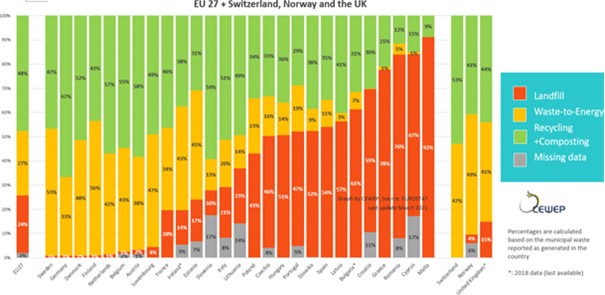MSW incineration fee in Norway
How to stimulate waste prevention and promote material recovery? Can a combustion fee be part of the solution?
Municipal solid waste (MSW) incineration (Waste-to-Energy, WtE) is excluded from the European Emissions Trading System (EU ETS). Some authorities, including Norway’s, have been considering the introduction of a specific combustion fee on WtE. In such a scheme, WtE plants will have to purchase CO2 equivalent emission credits for each tonne of fossil CO2 emitted when processing MSW. The main rationale is that the increased cost of incineration will act as an incentive to reduce waste production and to promote sorting and material recycling of fossil-based waste fractions, mainly plastic (and textiles). These trends could contribute both to climate change mitigation and EU material recovery targets – 6 5% by 2035 for MSW. The current MSW treatment situation in the EU is summarised in the picture below and shows that countries with high material recycling are most often countries with high WtE.

Municipal waste treatment in 2019 (from CEWEP, Eurostat data).
The actual effects of such a fee are difficult to predict. This is specifically true concerning waste reduction and households. Households will not be affected directly by the fee, as they do not usually have to pay for waste handling per kilogram, but they pay a fixed fee, often to their municipality, for waste treatment. Sweden implemented a waste incineration fee in April 2020 and evaluated its effects in January 2021. In short, the short-term effect on material recycling is limited and the long-term effects are uncertain. More details can be found in Utvärdering av avfallsförbränningsskatten, 8-861014, 2021, Skatteverket (in Swedish).
A real possibility in Norway is that MSW fractions will be exported to countries where WtE cheaper (mainly to neighbouring Sweden). WtE actors also argue that they have little influence on the amount and nature of the waste they are processing and that they act as the ultimate solution and sink for contaminated, mixed, residual fractions that cannot be treated otherwise for one reason or another (in accordance with the EU waste hierarchy).
Many in the the WtE sector, with the support of some political parties, have suggested that the economic burden of a fee should be moved higher up in the value chain to have a stronger impact on waste generation and material recycling, i.e. towards the producers of fossil-carbon products. A strengthening of the producer responsibility requirements may be more efficient than a combustion fee. Also, such a solution may very well be more in line with the polluter pays principle.
In Norway, the fee was proposed before being removed in 2021. It is again part of the 2022 state budget under the new Norwegian Government elected in September 2021. The proposed level is 192 NOK (ca. 19 €) per ton fossil CO2. Its effect on waste treatment in Norway will be interesting to follow.
Read more:
Utvärdering av avfallsförbränningsskatten, 8-861014, 2021, Skatteverket (in Swedish). https://skatteverket.se/download/18.96cca41179bad4b1aa991d/1633068526576/Utv%C3%A4rdering%20av%20avfallsf%C3%B6rbr%C3%A4nningsskatten.pdf
Waste incineration under the EU ETS, 2021, CE Delft. https://zerowasteeurope.eu/wp-content/uploads/2021/10/ZWE_Delft_Oct21_Waste_Incineration_EUETS_Study.pdf
The Norwegian Government website, in Norwegian, 2021. Endringer i klimaavgiftene https://www.regjeringen.no/no/statsbudsjett/2022/tilleggsnummer/tilleggsnummer-til-statsbudsjettet-2022-skatter-og-avgifter/tilleggsnummer-til-statsbudsjettet-2022-endringer-i-klimaavgiftene/id2884934/
The Norwegian Waste Branch Association, 2021, https://avfallnorge.no/bransjen/nyheter/forbrenningsavgift-karbonfangst-eller-ravareavgift (In Norwegian)


